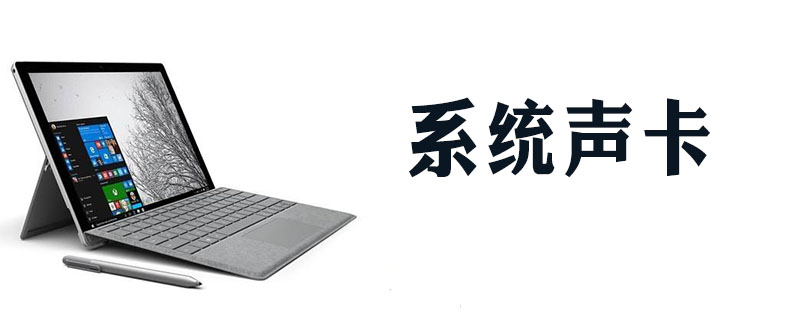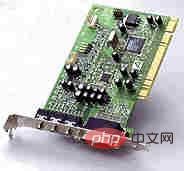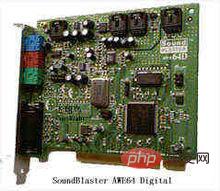Home >Operation and Maintenance >Windows Operation and Maintenance >What is the sound card of win7 system?
What is the sound card of win7 system?
- angryTomOriginal
- 2019-08-21 09:11:523768browse

Sound Card (Sound Card) is also called audio card (called sound effect card in Hong Kong and Taiwan): Sound card is the most basic component of multimedia technology, which realizes the mutual conversion of sound waves/digital signals. a piece of hardware.
The basic function of a sound card is to convert the original sound signals from microphones, tapes, and compact discs, and output them to sound equipment such as headphones, speakers, amplifiers, and recorders, or to make musical instruments emit sounds through the Music Equipment Digital Interface (MIDI). Wonderful sound.
Recommended tutorial: Windows system graphic tutorial
Working principle
The sound card obtains the sound analog signal from the microphone, converts the sound wave amplitude signal sample into a series of digital signals through an analog-to-digital converter (ADC), and stores it in the computer. During playback, these digital signals are sent to a digital-to-analog converter (DAC), restored to analog waveforms at the same sampling speed, and then amplified and sent to speakers for sound production. This technology is called pulse code modulation (PCM).

Main functions
Digital sound files. Through the control of the sound card and the corresponding driver, signals from microphones, radio recorders and other sound sources are collected, compressed and stored in the memory or hard disk of the computer system.
The digital sound files compressed by the laser disc are restored into high-quality sound signals, which are amplified and played through the speakers.
Digital sound files are processed to achieve a specific audio effect.
Volume, combine various sound sources to realize the function of reverberation.
Synthesis technology reads text information through the sound card. Such as reading English words and sentences, playing music, etc.
Audio recognition function allows the operator to use passwords to command the computer to work.
Electronic musical instruments. In addition, with the help of the driver, the sound card can output files stored in MIDI format to the corresponding electronic musical instruments and produce corresponding sounds. Make electronic musical instruments commanded by the sound card.

Technical indicators
Sampling rate
The sampling rate refers to the frequency with which samples are collected from the original sound waveform. The higher the sampling rate, the smaller the difference between the recorded sound signal and the original signal. The unit of sampling rate is kHz, and professional sound cards usually provide the following concentrated sampling rates: 32/24/44.1/48/88.2/96kHZ.
Sampling Accuracy
Sampling accuracy value is the accuracy of measuring the volume when performing "analog-to-digital" conversion of sound. Just like a ruler with more precise scales will measure the length more accurately, the higher the sampling accuracy, the more delicate the sound will sound and the less obvious the "digital" taste will be. The sampling precision supported by professional sound cards usually includes: 16bit/18bit/20bit/24bit.
For finished sound products, the most commonly used sound quality standard is 16bit/44.1kHz, which is CD quality. No matter how high the sampling rate and sampling precision is used during recording, when the stereo audio file is finally generated, the sound must be formatted to the CD standard so that it can be played smoothly on most audio equipment.
The advantage of recording with a standard higher than CD sound quality is that if the sound source signal cannot be guaranteed to be highly consistent with the original waveform, then after multiple processes, the difference will increase significantly. In addition, by recording audio with a high sampling rate and sampling accuracy, quantization noise will be reduced to a minimum.
Distortion degree
Distortion degree represents the difference between the processed signal and the original waveform, which is a percentage value. The smaller the value, the more seriously the sound card can record or reproduce the original appearance of the musical work.
Signal-to-noise ratio
The signal-to-noise ratio refers to the ratio of the effective signal to the background noise, expressed as a percentage. The higher the value, the smaller the noise caused by the equipment itself.
The above is the detailed content of What is the sound card of win7 system?. For more information, please follow other related articles on the PHP Chinese website!

